Moving a small family of two adults and a dog, their home on wheels, and all their belongings between two continents that are not connected by road is not an easy or straightforward task. I’m planning to post several blogs about the procedures, the execution, and the impact over the coming weeks. To avoid information and sensory overload, I will split some of these topics over two entries, an informative one and a personal one. Today, I will provide facts and tips about how to actually ship your vehicle abroad. The next blog in the series will elaborate on our personal challenges and experiences going this route.
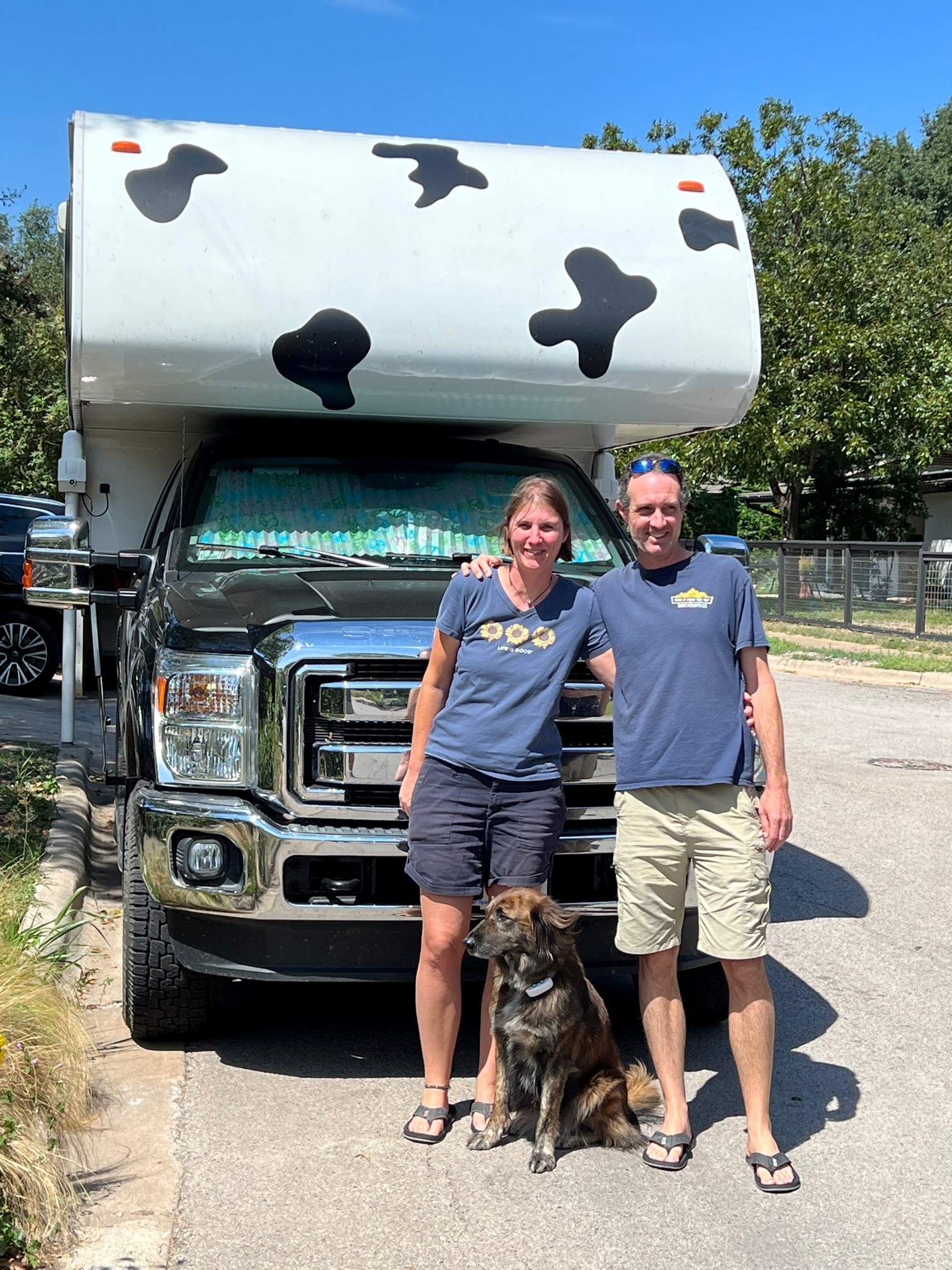
Liesbet, Mark, Maya, and Thirsty Bella
1. Decide on a shipping method: RoRo or container
The two most common ways to ship a vehicle, whether it’s a car, motorcycle, van, or RV, are via a container or a RoRo (Roll-on Roll-off) ship. Less frequent is LoLo, which means being parked on a flat rack of a container ship, at which point, it’s usually cheaper to opt for RoRo. All three fit the category cargo ship. Your choice most likely will boil down to size restrictions.
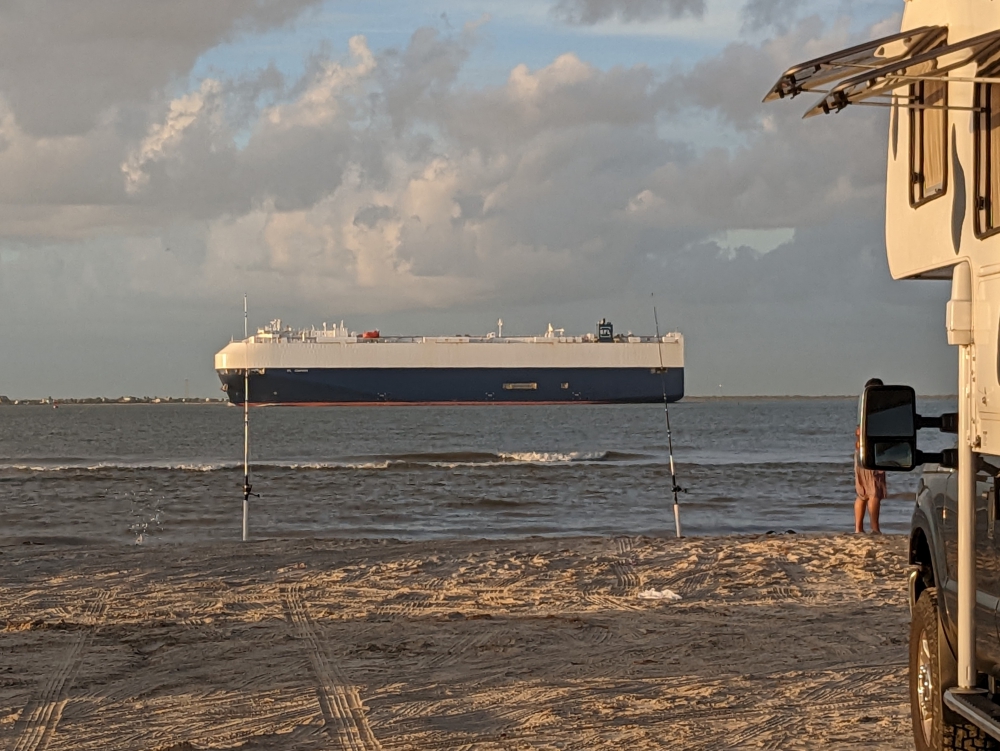
RoRo ship or car carrier
The safest, most secure, and cheapest way to ship a vehicle is in a standard container. These come in three lengths; 10 feet (~3 meters), 20 feet (~6 meters), and 40 feet (~12 meters). The most cost-effective option when you have a car or low-rise van is to share a 40ft container with someone else. The maximum height of these containers ranges between “standard” height (8.5 feet or 2.59 meters) and “high cube” (9.5 feet or 2.74 meters) and their width is 8ft.
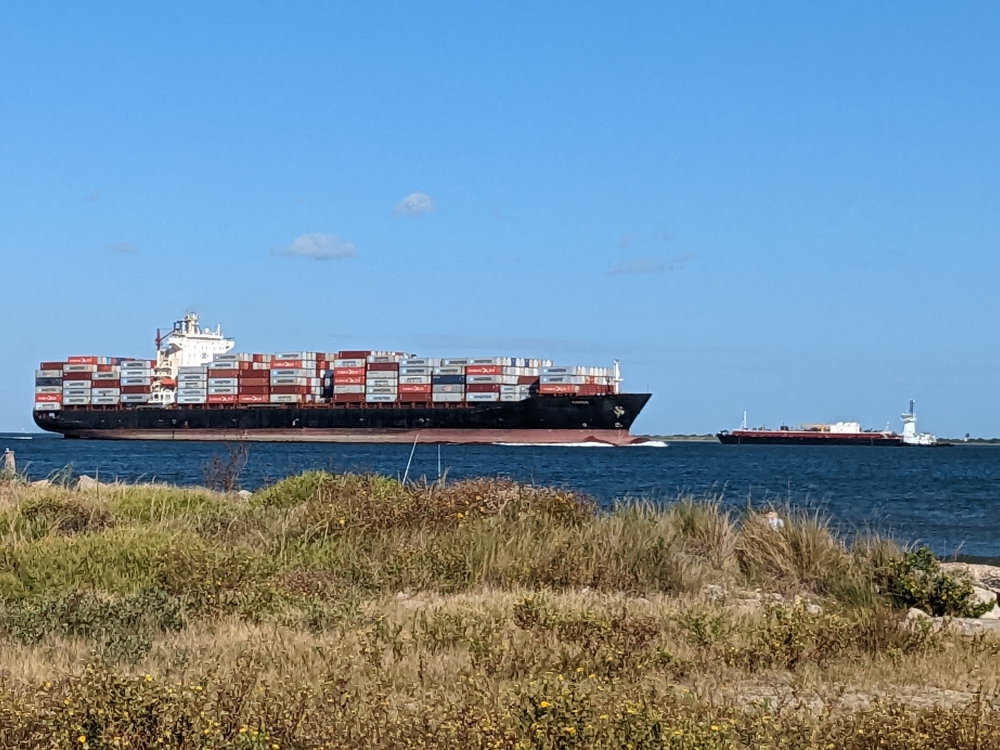
Container ship in Galveston
The dimensions of Thirsty Bella are 21.8ft (6.65m) of length, 8.8ft (2.67m) of width, and a height of 10.5ft (3.20m). We could have potentially separated the truck and the camper to fit in a 40ft container lengthwise, but the camper part would still be too wide. Therefore, we had to ship our vehicle with RoRo, which means it’s not enclosed and locked up. You drop the camper off at a port (Galveston, Texas, in our case) and leave the key of the truck. An employee drives and parks it onto the ship (roll on), and an employee of the arrival port (Cartagena, Colombia, in our case), moves the vehicle on shore (roll off).

Thirsty Bella
2. Decide on a route
There are several routes between the United States and South America. The US has departure ports on the East and West coasts and in Texas. Arrival ports include Colombia, Chili, Ecuador, and Uruguay. You can also ship to/from the east coast of Mexico and Colon, Panama, the shortest distance to Cartagena. As mentioned in a previous post, the Pan-American highway does not connect the countries of Panama and Colombia, due to the notorious and inaccessible Darien Gap, so you have to put your vehicle on a ship if you want to explore South America overland.
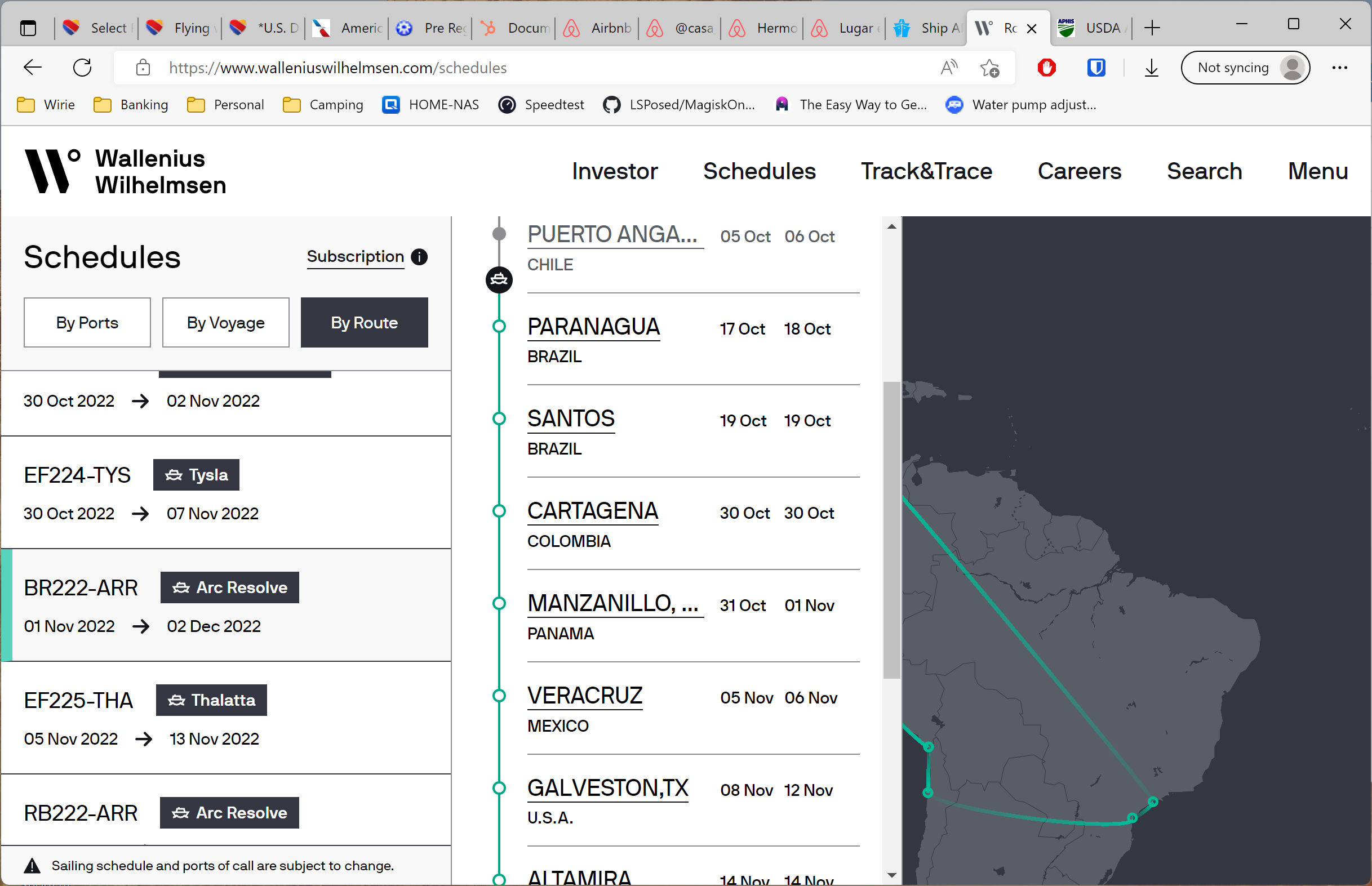
One of the boat routes/schedules
3. Research shipping agents and book a slot
None of the shipping companies allow customers to go directly through them. Therefore, you need to contact and enlist the help of an agent. The shipping agency arranges most of the paperwork and you pay all your fees, except the ones related to the arrival of the vehicle, to them. During your research, make sure they represent your shipping method (in our case RoRo), are transparent about their fees and involvement, and are responsive, professional, and established. Read the reviews carefully and, ideally, start a relationship or rapport before booking a slot.
Request a quote (easy to do online with IVSS), make sure they represent the route you are interested in, and understand all the rules of the shipping company they work with. There are quite a few restrictions and guidelines.
We decided to go with IVSS (International Vehicle Shipping Services), because of their positive reviews, competitive prices, involvement and help on forums, and adequate response time. They are based in the UK and collaborate with the shipping line Wallenius Wilhelmson. Martin McGowan is helpful, friendly, resourceful, and the main contact person, while Nicole Cardozo seems to take care of the paperwork. In our case, some mistakes were made by this agency, which affected us mentally, logistically, and financially. More about that in a future post.
4. Be flexible and keep an eye on the shipping schedules
This is a stressful time. Once you have a “tentative” departure and drop-off time for your vehicle, the waiting and scrutinizing starts. Or, if you are less uptight than us, you can just adopt the “wait and see” attitude, count on your agent to keep you posted about changes (we don’t recommend this as it’s on you to make sure you know the schedule changes), and book your plane tickets and accommodation around these unknowns, meaning everything has to be flexible and cancellable, including your schedule, mindset, and logistics. Sailing schedules, ports of call, and therefore routes are subject to change!

The ship arriving in Galveston
5. Prepare your camper for the journey
Based on your destination – and complications – your vehicle will be at sea for multiple weeks. Make sure every item is securely stored or tightened, take all valuables and gadgets with you on the plane, and hide or arrange important items (like tools, expensive toys, keepsakes…) in areas that are difficult to access or require a separate key.
Your preparations will focus on the safety of the vehicle, the storing of your belongings, and the (unwanted) access to the interior or cupboards. This last concern is a double-edged sword: Customs needs access to all parts of the camper for potential inspections, but you don’t want shipping personnel or dock workers to be able to access anything unauthorized.
We have a truck camper, which means there is a separate entrance to get into the camper part. You technically must allow access to ALL parts of the vehicle, but we suggest only leaving the key to the car if you’re not asked otherwise. It is strongly advised to empty the entire cabin of the vehicle and store those items (including seat covers, floormats, tools, and contents in the glove compartment and on/under the back seat) in the camper. Ideally, like us, you have a keyless lock to enter the habitat and you give the code (after changing it) to the agent, who, if necessary, can share this information with Customs. If you have a van or Class C camper, it is recommended to somehow build a barrier between the driving and living compartments.
The way you prepare or secure your camper – apart from the requirements set by the shipping company – is mostly personal. Some people attach a metal bar in front of their camper door, others build contraptions to prevent break-ins or access to certain areas, and a big percentage of shippers doesn’t make any special preparations; they just lock up shop and hope for the best. It took us three days to reorganize, secure, hide, and remove certain items, and install wooden boards and tension bars to block access via our four large camper windows.
In general, Wallenius Wilhelmson’s rules include: no transportation of food, propane tanks have to be empty and accompanied by an official certificate stating so, the gas tank of the car has to be less than ¼ full, and every item has to be stored and hidden from view.
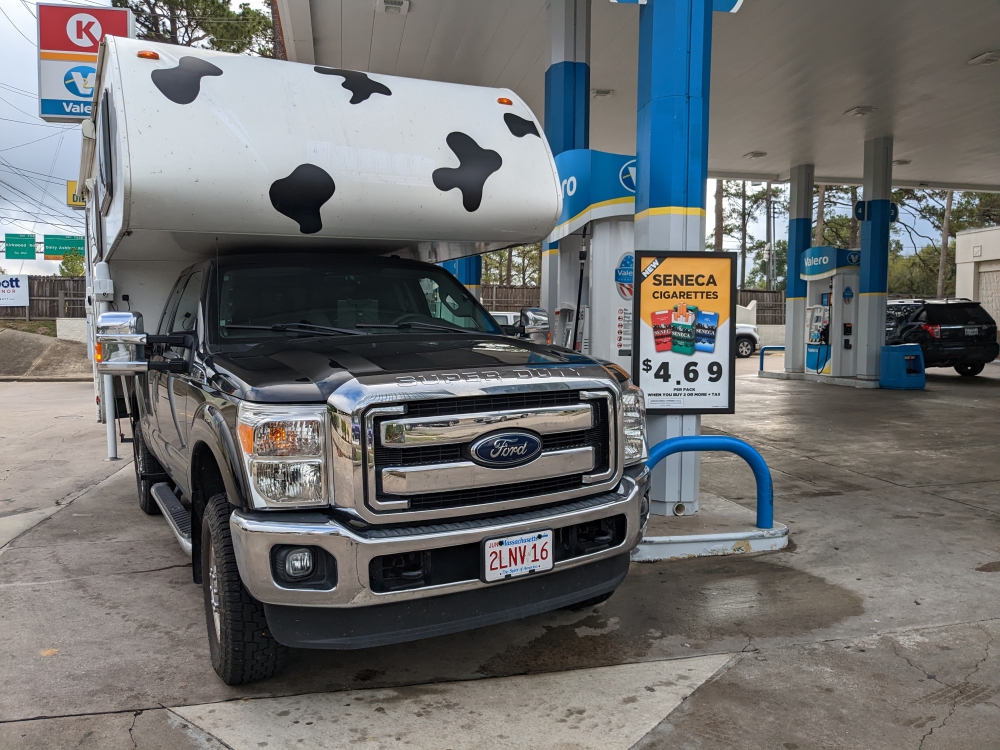
Last fuel up in the US, making sure it’s not more than 1/4 tank
6. Drop the vehicle off in the port of departure
A port escort is needed for this step. You are responsible to get contact information of port escorts, make an appointment on the day of your vehicle’s drop-off, and confirm the address. The escort stays with you from the moment you arrive at the port, throughout all necessary procedures and inspections (like checking the proof that your propane cylinders are empty), until the moment you leave the gated entrance (by foot). In Galveston, Texas, you pay $50 per hour and once it’s ten minutes over, another hour gets tacked on. Usually, one hour is enough to get everything accomplished on location.
The owner of the vehicle is responsible to visit Customs the same day as well, to obtain the necessary clearance and stamps. In Galveston, the camper has to be dropped off four business days before the arrival date of the ship you are scheduled to depart on. It is recommended you don’t leave the country until your vehicle does. Logistically, especially when you are a nomad, this camper is your only home, and delays occur, this situation creates extra challenges and expenses.

Proof the car has been dropped off at the port
You pay for the transportation and agent fees from the moment your vehicle has left the departure port. The costs are based on the size of the rig. For a truck camper, expect to pay between US$4,000 and US$5,000. The journey from Galveston to Cartagena is supposed to take 7-10 days…
7. Arrange and pay a local “receiving” agent
Usually, the agency you work with in your native language has contacts in the city of arrival. You can either use “their” agent for the receiving process or contact one yourself. Language might be a barrier, which is one of the reasons we went with the agency IVSS works with in Cartagena, namely Summit Cargo. In reality, only one of its employees speaks English, Rodolfo. Ask for him at all times.
Once you physically arrive in Cartagena, at least one trip to the agency is required, to sign forms and pay the fees to retrieve your vehicle from the port, which are around US$1,000. Together, you also visit a Customs agent nearby, and, ideally, your Colombian agent arranges the mandatory liability vehicle insurance (SOAT) for you. It takes a little while to get all the paperwork established. When your camper arrives at the port of Cartagena (which is different for container and RoRo ships), expect to wait another two or three workdays before being reunited.
If we could do it over again, we would hire the well-regarded, respected, and accomplished local agent Ana Rodriguez. We did contact her ahead of time, but since her quote was similar to the one IVSS provided for their Colombian partner (which was wrong), we stuck with them.
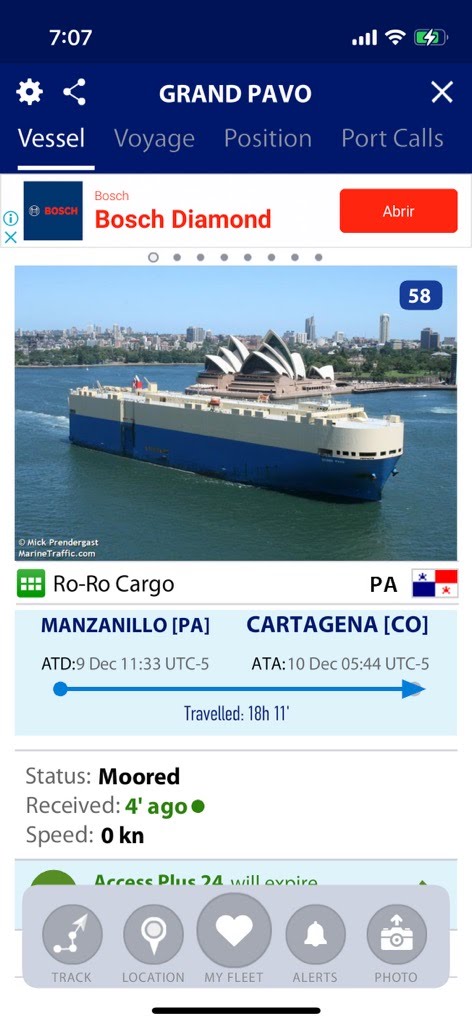
The car carrier arrives in Cartagena
8. Pick up at the port of arrival
Only the owner of the car is allowed inside the harbour area, in the company of the local agent. In our case, eight campers arriving on the same ship were assigned to Rodolfo, so he joined that group of people to the port on a particular day and, one by one, arranged for the paperwork, inspection, and pick up. Family members (and pets) have to secure transportation (and accommodation) for that day, ideally close to the port. Count on at least half a day for the pick-up procedure.
9. Make sure you have local car insurance
The mandatory national liability insurance goes into effect at midnight on the day you purchase the policy. Because of complications, our SOAT didn’t start until the night of our camper pickup. A bit nerve-wrecking, but everything worked out in the end. We tried to arrange the paperwork and policy online ahead of time, but were unsuccessful. This might be possible in the future.
10. Put the camper back together for your overland adventures
After you pick up your vehicle in Cartagena and after having been there, waiting, for possibly many weeks (five in our case!), you are antsy to leave this hot, humid, hectic, and dirty city. But first, you have to get everything ready for the road again. You need (potable) water, propane, fuel, and groceries. And you have to reorganize the camper and cab areas. But you don’t want to return to the busy, dangerous traffic of downtown.
These steps require planning and patience. We recommend staying the first night after pick up in a hotel with a parking lot outside the city. In our case Hotel La Via was adequate. Nevertheless, we “camped” in our camper the first few days on the road until we reached the cooler temperatures of the mountains, before we reorganized our living quarters and really started this grand adventure.
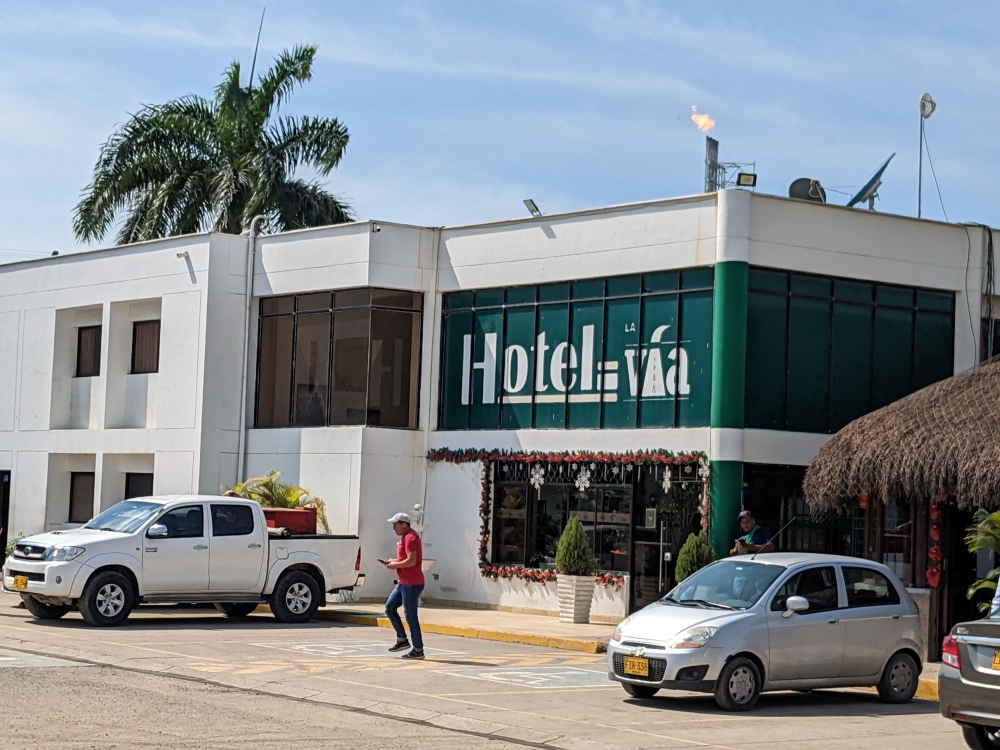
We spent one night at this hotel to get somewhat organized before hitting the road.
Our shipping circumstances were less than ideal and turned into a bit of a saga. And, of course there are many more steps and logistics involved to move people, animals, and belongings across borders, but those stories are for another day.
Curious about a previous ten-year chapter in our nomadic lives, which includes eight years aboard a 35-foot sailboat in the tropics, check out my compelling, inspiring, and refreshingly honest travel memoir:





























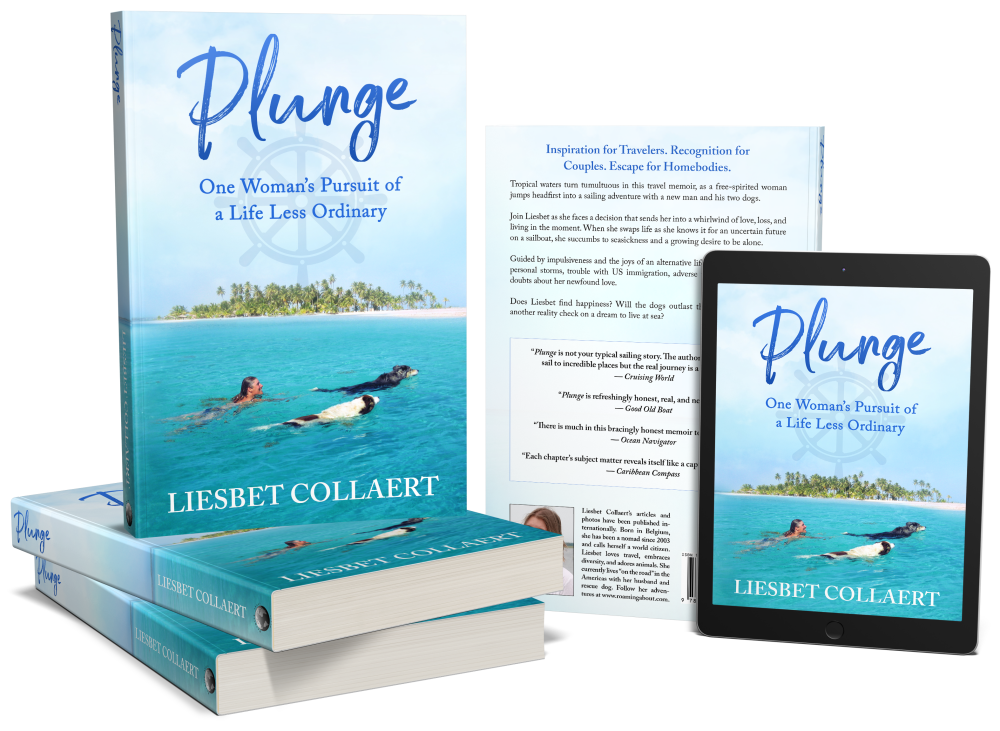




January 6, 2023 at 11:22
I got dizzy reading all of the steps needed to make the “move” – so many “moving steps”!!! Glad it’s all been accomplished now, but wow, a lot of headaches and stress and worry. But you and Mark DID IT!!! Well, as did Maya and Bella. xo
January 7, 2023 at 14:11
Thanks for reading and commenting, Pam. This episode was only one piece of the puzzle. And just the logistics part of that piece. The amount of things that went wrong is what made this episode less than ideal. If everything would have gone according to plan, our leading up time in Texas and our initial weeks in Cartagena might actually have been somewhat pleasant. 🙂
January 6, 2023 at 12:22
Great explanation of the process. You did great to make all this happen and be roaming about in SA now!
I’ve often thought that hiding stuff under the full composting toilet bag would be a good spot – because once someone opens the lid I doubt they want to look any further.
Looking forward to your next post about the shipping adventure.
Greetings from us in North America!
January 7, 2023 at 14:29
Hi Duwan,
I guess we did reach our goal of being all ready to travel again, in a different continent, by the end of the year. Barely. So much went wrong. But then again, it could have been worse. 🙂
On hindsight, we prepared too well. In a way, that made us “miss” our initial ship – although the blame for that lies with the agent. But you never know. We had no idea that nobody would enter or inspect our camper. It could have gone the other way, though, so better safe than sorry.
I think the entire episode was mostly mentally and financially taxing. Other than that, it was “just” time.
January 6, 2023 at 12:23
I cannot believe how complicated that is. Oh. My. Goodness. Kudos for getting through it all with style.
January 7, 2023 at 14:31
Thanks, Jacqui. Although I have to admit that there was a lot of complaining going on in November when we were “stuck” in Cartagena, waiting for our home to show up. 🙂
January 6, 2023 at 12:36
Hi, Liesbet – Like Pam my head is spinning with all that was required. I definitely think that your SA adventures should be your next book (or, at least, one of your books if there is aleady one in the pipeline!
January 7, 2023 at 14:33
No books in the pipeline, Donna. Life is too busy with other priorities right now. But, I am taking a lot of notes and my diary has grown to an hour every evening! 🙂 If I write a second travel memoir, it will focus on South America.
We’ve only been here for three weeks and the ups and downs have been extreme already! You’ll have to stay tuned for that.
January 6, 2023 at 14:37
Oh, gosh! I knew there was a lot to the procedure, but you could teach a class wit all the steps needed. Jumping through all the necessary steps further demonstrates your resolve. What is the price of fuel like in South America?
January 7, 2023 at 14:38
Mark is very good at research, as you know (and as you are), Pete. But we have found that when you are too much on top of everything, you never relax. So much doesn’t go according to plan, which leads to stress and frustration.
We’ve become experts in so many fields, where we often give the real professionals advice, updates, and tips. Because we stay on top of things and need to understand everything. It’s crazy. And it wasn’t different in this situation, where the shipping agent relied on us at times. We actually initiated a process that sped things up by two weeks in the end! Not only did we benefit from that, but so did twenty other couples and the agent himself. But more about that another time.
Fuel in Colombia is affordable and we love that! Diesel and gasoline are around the same price, about US$2 a gallon. 🙂
January 6, 2023 at 15:05
Wow! It is hard to believe the things you had to do to get your home to Columbia. Unbelievable! We are going to keep these details in a place where we can find it if we ever decide to follow in your footsteps. No time soon, but one never knows. Glad you are safe. Jim
January 7, 2023 at 14:40
Thanks for reading and contemplating, Jim. If you ever come to South America to travel overland in your own vehicle, I strongly recommend a rig that is similar or smaller than ours. Thirsty Bella proves to be quite tall and wide for most towns we pass!! But, we have finally learned, the hard way, to stick to the major throughways and park on the edge of town (and walk) if we need groceries.
January 6, 2023 at 16:37
What a complex process with so many opportunities for things to go wrong! It must have been so stressful for you. I guess the only good news in all this is that when you’re finally ready to return to North America, you’ll know the ropes. Congratulations on finally being on the road – safe travels!
January 7, 2023 at 14:44
Hi Diane,
You nailed it again. There were so many moving parts and so much that could go wrong (and did), indeed. I would have never guessed. This will be obvious when I post our personal story and experiences. I can honestly say that I’m glad a new year has started.
About returning to North America… Hmmmmm. Not sure if that will ever happen – with or without Thirsty Bella. Time will tell.
Thanks for the safe travel wishes. We are slowly finding our groove, after recovering from an attempted armed robbery. But that’s, yet, another story.
January 7, 2023 at 16:34
Yikes, that’s terrifying! I’m marvelling that you’re still there – after something like that, I would have been on the first plane back to Canada. Stay safe!
January 7, 2023 at 19:31
Don’t forget we don’t have a home anywhere to return to. 🙂 At the moment, we wouldn’t want to be anywhere else than here in Colombia. And, we know – and have experienced – that the majority of the people we meet are incredible. We should not forget that. Fear cannot rule our life. On the flip side, we are more careful and cautious than ever before.
January 6, 2023 at 18:33
Hi Liesbet, you definitely need to submit this one to a camping magazine, or make it a chapter in your new book. I imagine there are lots of folks out there who would find this very helpful. I am glad you guys were successfully reunited and are now on to your new adventure.
January 7, 2023 at 14:48
Thanks, Suzanne. We are happy to be on the road again. Our confidence, freedom, and safety feeling got a little dent recently, but we are back in the swing of things now.
Topics like these are more article than blog material, so I appreciate your feedback about that. I really ought to get in the “paid writing” swing of things again. But, magazines need unpublished work. Mark and I just did our yearly expense report today (in draft) and the bottom line is that we spent more than we made in 2022… But that’s another topic. I’m hoping more like-minded people and travelers will find my blog with a “how to” story thrown in once in a while. This hopefully will lead to more book sales.
January 6, 2023 at 19:35
Wow, Liesbet, the details and moving parts to make this happen are innumerable! I’m so happy that it has all worked out for you. Keeping the RV protected from shipping as well as curious folks was worth the efforts and time. I read your previous posts about you sitting on pins and needles awaiting its arrival. Take a big breath, a sigh of relief and enjoy your travels. Looking forward to what comes next!
January 7, 2023 at 14:50
Thanks for the vote of confidence and the travel wishes, Terri. Yes, more than one event eventually ended well, as 2022 drew to a close. So many stories. So many photos. So many new places to experience and people to meet. 🙂
January 6, 2023 at 20:24
Hi Liesbet, Kudos to you and Mark for getting through the complicated procedures. I am glad you are with your home on wheels. Wishing you wonderful adventures in SA.
January 7, 2023 at 14:52
Thanks, Natalie. You have no idea how nice it feels to be reunited with our home and finally explore new locales again. Colombia is an amazing country and its people the most friendly and genuine we’ve ever met! I love that we don’t have time restrictions, especially compared to other travelers and overlanders. Right now, we are waiting out the last of the noisy and busy holidays. Then, we will drive and sightsee again.
January 6, 2023 at 21:31
I’m glad you’re safe and healthy and I’m looking forward to reading about your adventures. Are you going to drive all the way to Ushuaia?
January 7, 2023 at 14:55
Yes! We hope to explore the entire continent, with some back and forths, like in Colombia, and take our time. We will skip Venezuela, though, as it’s not safe there for foreigners, and we will keep an eye on potential developing situations elsewhere.
I’m definitely looking forward to Patagonia! No idea when we will get there, though. I’d love to do an Antarctica cruise as well, like you two, so I better start saving now! We expect to travel around the continent, non-stop, for the next three years.
January 6, 2023 at 22:49
I’m organized and tenacious, but I think this might have done me in! Yowza – what a process! You must be so relieved to be (sort of) back to normal.
January 7, 2023 at 14:58
Hi Lexie!
It actually feels strange not to be watching shipping schedules, be frustrated and stressed, and be in impatient anticipation anymore. That went on for months, as you know.
I think that’s one of the reasons why it feels so good to be living and traveling in Thirsty Bella again. We are our own boss and have our own home now. So. Darn. Nice! When things are out of our control (and keep going wrong), it doesn’t feel very good.
January 7, 2023 at 03:52
A fantastically detailed article, Liesbet. Filed for future reference…! 🙂
January 7, 2023 at 14:59
Thanks, Jackie. This is one of my few “how to” articles/blogs. I don’t know how you keep cranking them out as guest posts, articles, and your own blog posts. They require a lot of work and time. And – gasp – some research. 🙂
January 7, 2023 at 11:39
I agree with Pete, “you could teach a class with all the steps needed.” Over and over you and Mark show perseverance and resolve. You could write a book about those character traits in various settlings. On second thought, it may be too laborious, for as Anais Nin says, we “write to taste life twice.” Some, I’m guessing, you’d rather not relive.
Brava, Liesbet, mission accomplished, and now the next adventure continues! 😀
January 7, 2023 at 15:02
I really like that quote of Anais Nin, which I recently spotted on your blog as well, Marian. It would work better for good experiences, for sure! I have a few dramatic stories lined up in my diaries that would certainly make it into a second memoir. But, you are so right, writing at the moment does feel laborious to me. All I can muster is those hour long journal entries every evening. I’d rather focus on the current adventure in real life. 🙂
January 7, 2023 at 13:08
That is a lot of work and planning. Enough that I know I will never, ever transport a vehicle like that.
January 7, 2023 at 15:04
Haha, Alex. Because of all the work, determination, effort, time, and money involved in getting Thirsty Bella fixed, upgraded, and shipped, we have to spend a few years on this continent to make it all worthwhile! 🙂
January 7, 2023 at 20:47
Yikes, so many steps before you were on your way in SA. I imagine the internet has helpful advice from those who have gone before… I wonder what travelers did before they had that tool? You and Mark have learned to take things in stride over the years, and deal with the unexpected and disappointments, which are important skills.
January 10, 2023 at 13:28
I appreciate your positive spin on this, Janis. Yes, we have learned how to deal with the unexpected and disappointments. Pretty much every day, unfortunately, even now. I truly think that’s what will make us quit this lifestyle. Not so much the discomfort (which is what I initially guessed), but the fact that every day brings a new challenge or issue. (At the moment some serious leaks in our roof, while it keeps raining and when we need sunshine to dry things out.) Similar as on the boat, actually. And, we are people who prepare as much as we can ahead of time, to not run into problems…
In the days before the internet (which is when I backpacked for a couple of years and we had our one-year Central America overland trip), travelers were more relaxed and took things as they came. We’ve become too spoiled and want everything to be too perfect. Or, at least, to work out. 🙂
January 8, 2023 at 09:24
What a process that you navigated quite well. Impressive. Eight other campers came in with yours. That sounds like an interesting trend that is increasing.
Long term are you going to return to the US or fine/discover a country you like that is more economical and better easy health care system compared to the US? That will not be hard to do in South America. See you in February!
January 10, 2023 at 13:32
Hi Susan,
There were actually thirty campers on the same arrival ship to Cartagena, based on info we received from our agent. Maybe it’s this time of the year, maybe others had dealt with delays as well and eventually ended on the same ship, or maybe this trend is becoming more popular. Probably all of the above.
We don’t have long-term plans. We never do. We don’t think we will ship this vehicle back to the States or Europe regardless. It will all depend on how the camper does, what happens with Maya, and how we feel mentally and physically after a couple of years on this continent.
January 8, 2023 at 09:49
I’m sure this post will help many people over the years to come, Liesbet. It details so much, but that’s good, and I’d never have known about how it works if it were not for you. You guys look happy in the photos, though.
But I am concerned about what else you have to tell us. However, let the South American adventures begin.
January 10, 2023 at 13:36
Hi Hugh,
This was a relatively boring post, if you ask me. In it, I’m merely trying to provide some information for travelers in the same boat as us, or who are thinking about doing the same.
When I post our personal account, experiences, and feelings about this shipping episode, the story might be a bit more compelling, yet not too positive…
We have run into a few issues since we have been in Colombia. One of those stories (whenever I tell it publicly) will horrify you. The others are mainly just nuisances. None so far is making us change our minds about being here, however. 🙂
January 11, 2023 at 06:32
I didn’t find it boring because I was learning something new, and I love learning, Liesbet.
Good to hear nothing has made you change your minds about being in South America, although I’m intrigued by the horrifying story. That’s probably down to the dark side of me.
January 13, 2023 at 14:25
One day I’ll blog about the horrifying story, but the gist of it is that we managed to fend off an attempted armed robbery on Christmas Eve. It was scary, but we didn’t get harmed and nothing got stolen, which was the Christmas miracle. 🙂
January 14, 2023 at 06:52
Oh, my goodness, that sounds terrifying, Liesbet. I’m so sorry to hear what happened. So pleased you’re all safe and that nothing was stolen.
January 14, 2023 at 14:59
That Christmas Eve episode couldn’t have ended better, Hugh. Not sure why, but we all practiced the right attitude and demeanor to not escalate things and bring the attempted robbery to a good ending. We’ve learned a lot along the way.
January 15, 2023 at 06:00
I look forward to hearing more about it.
January 9, 2023 at 20:01
Just wow! I don’t know how you guys maintain the wherewithall. Your tips would possibly make a great guide for other nomads, no doubts! So glad everything arrived! <3
January 10, 2023 at 13:37
We sure have a few month of nail biting behind us, Debby, so you can imagine our relief – and tolerance – now that we are reunited with Thirsty Bella and doing what we set out to do. 🙂
January 10, 2023 at 00:14
Wow, I admire your patience and determination to make it all work. I don’t think I’d have the stamina…
January 10, 2023 at 13:39
Hi Debra,
I’m starting to worry about that stamina as well, especially because we keep running into issues. I feel every day, we have to practice that patience and determination. It’s time for some trade-offs and fun again! 🙂